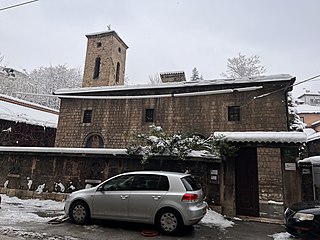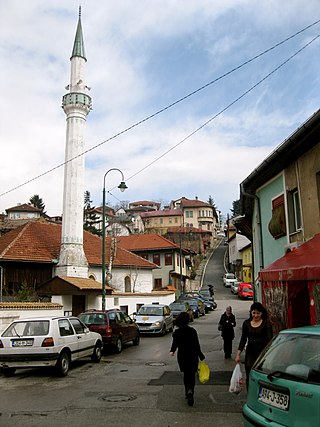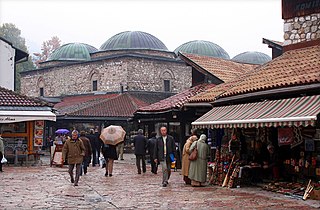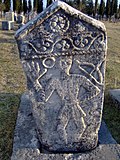
Novo Sarajevo is a municipality of the city of Sarajevo, Bosnia and Herzegovina.

The Sarajevo Canton, officially the Canton of Sarajevo, is one of the ten cantons of the Federation of Bosnia and Herzegovina in Bosnia and Herzegovina. Its cantonal seat is the city of Sarajevo, also the capital city of Bosnia and Herzegovina.

The University of Sarajevo is a public university located in Sarajevo, Bosnia and Herzegovina. It is the largest and oldest university in the country, tracing its initial origins to 1537 as an Islamic madrasa.

The National Museum of Bosnia and Herzegovina is located in central Sarajevo, the capital of Bosnia and Herzegovina.

Trnovo is a town and municipality located in Sarajevo Canton of the Federation of Bosnia and Herzegovina, an entity of Bosnia and Herzegovina. As of 2013, the municipality had a population of 1,502 inhabitants. The town itself had a total population of 1,023, with 956 of them living in the Republika Srpska part and 67 in the Federation part.

The Republic of Bosnia and Herzegovina was a state in Southeastern Europe, existing from 1992 to 1995. It is the direct legal predecessor to the modern-day state of Bosnia and Herzegovina.

The Church of the Holy Archangels Michael and Gabriel, also known as the Old Orthodox Church, is a Serbian Orthodox church in Sarajevo, Bosnia and Herzegovina. It was established in 1539. It was, however, built on older foundations.
Mejtaš is a neighbourhood of Bosnia and Herzegovina's capital Sarajevo, where it is located in the center of the city. The neighbourhood has some of the most expensive real estate properties in Sarajevo and it is one of the most prestigious parts in Sarajevo. It is also a residence of the former Chairman of the Council of Ministers of Bosnia and Herzegovina, Denis Zvizdić. The Federal Ministry of Finance and the Intelligence-Security Agency of Bosnia and Herzegovina are located in Mejtaš. The headquarters of the Party of Democratic Action, the country's most powerful political party, is located in Mejtaš. The area is also very close to "Vječna vatra" one of Sarajevo's main symbols. The neighborhoods houses the Black party of Sarajevo

Our Party is a social-liberal and multi-ethnic political party in Bosnia and Herzegovina, founded in 2008. Its current leader is Edin Forto. The party's founders are the Bosnian directors Danis Tanović and Dino Mustafić. The party aims to break the dominance of nationalist parties in the Bosnian political system. On 4 June 2016, Our Party became a member of the Alliance of Liberals and Democrats for Europe.

Sarajevo City Hall, known as Vijećnica, is located in the city of Sarajevo, Bosnia and Herzegovina. It was designed in 1891 by the Czech architect Karel Pařík, but criticisms by the minister, Baron Béni Kállay, caused him to stop working on the project. It was initially the largest and most representative building of the Austro-Hungarian period in Sarajevo and served as the city hall.

The Museum of Sarajevo 1878–1918 is located near the Latin Bridge in central Sarajevo, the capital of Bosnia and Herzegovina. The building had been Moritz Schiller's Delicatessen in 1914, the year that Franz Ferdinand, the heir presumptive to the throne of Austria-Hungary was shot dead by Gavrilo Princip from the street corner outside, indirectly starting World War I.

Despić House is an old merchant house in Sarajevo, Bosnia and Herzegovina that was established in 1881 by one of the wealthiest and most prominent Serb families in Sarajevo. It is a branch of the Museum of Sarajevo.

Bradina is a village in the municipality of Konjic in Herzegovina, Federation of Bosnia and Herzegovina, Bosnia and Herzegovina.

The Historical Museum of Bosnia and Herzegovina is a museum in Sarajevo, Bosnia and Herzegovina.
The following is a timeline of the history of the city of Sarajevo, Bosnia and Herzegovina.

Museum of Sarajevo, also Museum of the City of Sarajevo, is a museum of history and culture of Sarajevo, located in Stari Grad Municipality of the City of Sarajevo, Bosnia and Herzegovina. The museum is operated by JU Muzej Sarajeva, and housed in 19th century Bosnian biographer, Kosta Hörmann's Villa, in Josipa Štadlera 32 street on the municipality of Stari Grad.

The Vekil-Harrach or Hadžijska mosque is a mosque in the city of Sarajevo, Bosnia and Herzegovina. It is located in Alifakovac, a neighborhood in Babića bašća local community, one of the oldest urban settlements in Sarajevo.

Muslihudin Čekrekčija Mosque, also known as Čaršijska, is second oldest domed mosque in Sarajevo. It was constructed in 1526 in the Baščaršija area of the city, at the foot of Kovač. It is raised in the mahala of Isa-Bey's turn. From the vakufnam of the founder of the mosque, Hajji Mustafa, the son of Ishak, is known to the people as Muslihudin Čekrekčija, her builder. This is also the oldest known original document written in Sarajevo.

Villa Mandić is an eclectic-style villa located in the Petrakijina Street in Bosnia and Herzegovina's capital Sarajevo.

Brusa bezistan with its 6 roof domes it is one of the historic buildings in Sarajevo's Baščaršija from the time of the Ottoman period in the history of Bosnia and Herzegovina. It has a rectangular base and has four entrances on all four sides, and connects the craft streets Kundurdžiluk, Veliki and Mali Čurčiluk with Abadžiluk and the Baščaršija. It was built by order of the Grand Vizier Rustem-pasha Opuković in 1551. Bezistan was named after the Turkish city of Bursa, from which silk was brought to Bezistan and sold. Unlike Gazi Husrev-beg's bezistan, where groceries were originally sold, Brusa bezistan sold household items and small furniture in addition to silk. Today it is one of the museums in the city, designated as the National monument of Bosnia and Herzegovina by the Commission to preserve national monuments of Bosnia and Herzegovina, and houses one of the departments of Museum of Sarajevo.





















